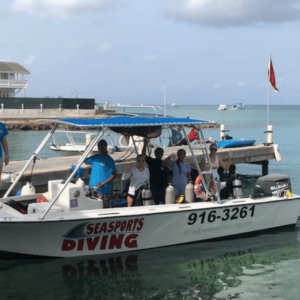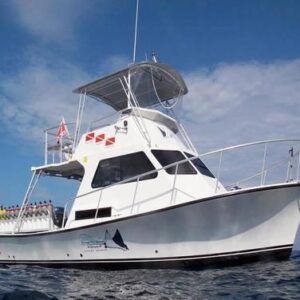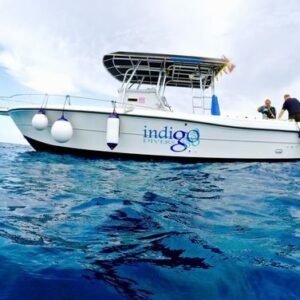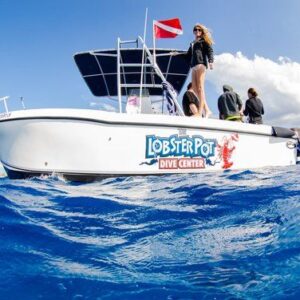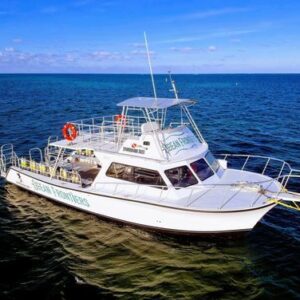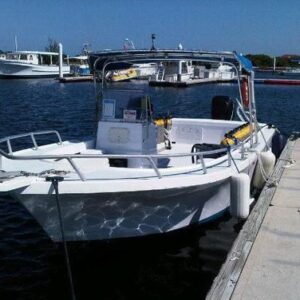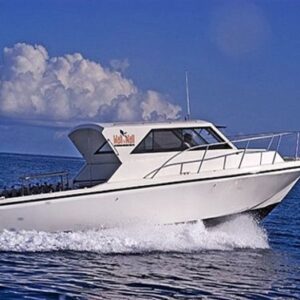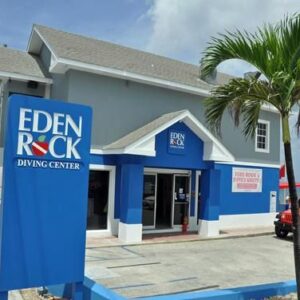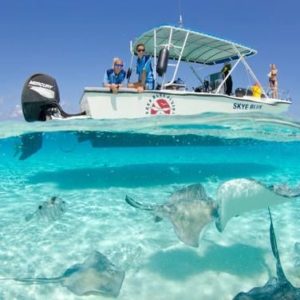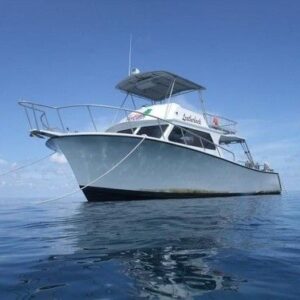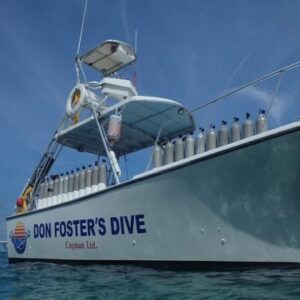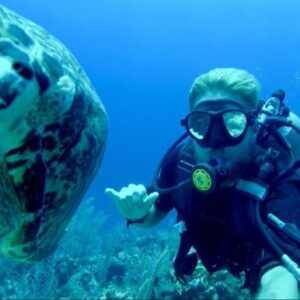Cayman Islands is considered one of the top diving destinations in the world. With 365 marked diving sites, beginners as well as thrill-seekers have incredible diving experiences. The three islands of the Caymans: Grand Cayman, Little Cayman and Cayman Brac are surrounded by environmentally protected reefs. This seclusion keeps the ocean clean and clear and the coral healthy. The Caymans rest on submerged mountains which provides this area with the most spectacular and dramatic seawalls in the Caribbean. Along with shallow reefs and storied shipwrecks, the Caymans are a diver’s dream.
GETTING THERE
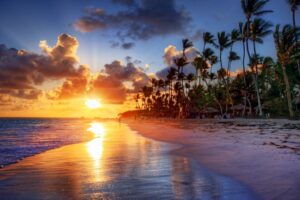
Air: Direct flights from Miami to Grand Cayman take only 70 minutes. From Grand Cayman flights to Little Cayman and Cayman Brac are offered.
GETTING AROUND
Grand Cayman: Grand Cayman is easy to navigate with a wide variety of transportation options.
- Car Rentals: The easiest way to get around Grand Cayman is by car.
Alamo Rent A Car 345.945.7368, Avis Cico 345.949.2468, Hertz 345.943.4378
Little Cayman:
- Car Rentals: Little Cayman Car Rentals: Provides daily and weekly care rentals. 345.948.1000
- Scooteni! Scooters! Scooter and Moped Rental 345.916.4971
Cayman Brac:
- Car Rentals: B&S Motors Ventures 345.948.1646, CB Rental Cars 345.948.2424, and Four D’s 345.948.1599
GOOD TO KNOW
Country: North America
Time Zone: Eastern Standard Time
Primary Language: English
Currency: Cayman Islands Dollar (CI$) / US Dollar is Widely Accepted.
Cell Phone Service: International Roaming is Required
Voltage: 120V
Passport and Visa: Required passport is needed unless traveling from the United States.
Hurricane Details: Hurricane season is June 1st through November 30th.
DIVE CONDITIONS
Water Temperature: 78 degrees – 87 degrees
Water Visibility: 60-100 feet
When to Go: April and May are the best scuba months but anytime is great.
Diving Difficulty: Beginner – Advanced
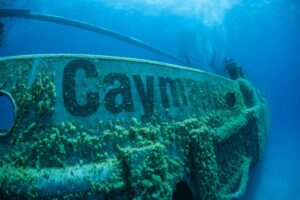
TOP DIVE SITES IN CAYMAN ISLANDS
Grand Cayman is the largest of the three islands. Popular attractions include the award-winning Seven Mile Beach and Stingray City.
Grand Cayman Dive Sites:
- Doc Poulson is a 70-foot cable-laying shipwreck sunk as an artificial reef. It is located off Seven Mile Beach and sits upright on a bed of sand. Doc Poulson was sunk in 1981 and is intact and safe to penetrate. This is a perfect shallow dive for beginners and second tanks. The wreck is encrusted with brain corals and an abundance of parrot fish and angle fish can be spotted here.
- The LCM David Nicholson is a 50-foot WWII landing craft that sits upright in 65-feet of water. This site is popular with those interested in warship wrecks and the reefs they create. Located close to this wreck is a 9-feet tall, 900-pound bronze statue of a mermaid.
- Kittiwate is a 251-foot, 2,200-ton, five decked submarine rescue vessel that was in service from 1945-1994. After 50 years of service, Kittiwate was decommissioned in 1994. This dive provides both snorkeling and diving.
- The Guardian of the Reef was sunk in January 2014. It sits under 65-feet of water just off Lighthouse Point on the island’s northwest point. This is the newest addition to Grand Cayman’s wreck dives.
- Stingray City is a popular attraction for divers and photographers. Local anglers are to thank for this site. They used this area to clean their catch and attract stingrays to the area. Large groups of stingrays gather here daily. Dives here are shallow and divers will enjoy up close and personal encounters with stingrays.
- Babylon is surrounded by a wall with a canyon cutting the north wall. All levels of divers can enjoy this site with plenty of shallow areas and deeper areas. Divers will spot black coral sponges, barrel sponges and sea fans where barracudas, turtles, eagle rays and parrot fish congregate.
Grand Cayman Land Sites:
- Pedro St. James National Historic Site is known as the oldest surviving stone structure on the island. Pedro St. James is home to cultural and historical stories and artifacts.
- Awardart Co LTD highlights the finest local art including paintings, sculpture, up-cycled art, and bespoke furniture.
- Heritage Beach is located in the East End. This small beach is a perfect place for a picnic lunch along the seaside. Although not suited for swimming, visitors can see turtle grass that forms an ecosystem that is important to diverse marine life.
Cayman Brac is named for its breathtaking bluff. This island is off the beaten track but is home to charming towns such as West End, Watering Place, Cotton Tree Bay, and Spot Bay. These quaint towns offer visitors relaxing accommodations perfect for those wanting a laidback experience after a day of adventure. Dives off Cayman Brac include limestone caves and sinkholes. The waters have sunken ships as well as awe-inspiring seawalls. Beginners as well as advanced divers can have fantastic diving adventures.
Cayman Brac Dive Sites:
- The MV Capt. Keith Tibbetts is a 330-foot Russian frigate. It was intentionally sunk off Brac’s West End in 1996. This vessel sits in 50-100 feet of water and is the only Russian warship available for dives. Divers can penetrate the ship’s top three decks.
- Anchor Wall is named after the enormous anchor that was accidentally entrenched in the reef. Divers will enjoy colorful sea life and corals just 90 feet beneath the surface. Swim-throughs are found on the inside of the wall and travel beneath the anchor.
Cayman Brac Land Sites:
- Cayman Brac Heritage House is free to the public. This modern version of an old Caymanian home gives visitors a sample of Caymanian heritage. The Cayman Brac Heritage House is located on an acre of land in the Northeast Bay. Community cultural events, artists, and historical exhibits are held here. The acre of land shows off both native and imported trees and flora.
- Cayman Brac Museum “Keeping in touch with the past” is the motto of the oldest museum in the Cayman Islands. Visitors can explore the history of the Caymans through displays and exhibits that include turtling, shipbuilding, home life and medical advancements. The local community has donated many of the artifacts which are thousands of years old.
- Brac Reef Beach is a picturesque location located at the Cayman Brac Beach Reef Resort. Visitors can enjoy diving, snorkeling, fishing, and kayaking explorations. There are tables, boardwalks, cabanas, and hammocks for relaxing.
Little Cayman is a laid-back and less developed island with incredible diving opportunities. The most famous is the renowned Bloody Bay Wall. There are also over 50 dive sites where divers can drop down over 6,000 feet. Although the diving is exceptional, topside attractions are limited. Little Cayman is for those looking to relax and get away topside and thrill-seek underwater.
Little Cayman Dive Sites:
- Bloody Bay Wall is a favorite among divers. Protected by Bloody Bay Marine Park, this area offers outstanding marine life. The wall drop is electrifying, reaching 6500 feet. Along the drop, divers can observe yellow tube sponges, black and wire corals, sea fans, triggerfish, eagle rays, turtles, and lobsters.
- Jackson’s Bight is also located in the Bloody Bay Marine Park. Here, divers will find many tunnels, chutes, crevices, and reefs. Eagle rays, reef sharks, sailfin blennies, peacock flounders, garden eels and yellow-headed jawfish are often spotted here.
Little Cayman Land Sites:
- Owen Island is a small islet just off the southwest shore and is the epitome of a tropical escape.
BEST SNORKELING IN THE CAYMAN ISLANDS
Thanks to shallow depths and calm waters, many of the most popular diving sites in the Cayman Islands are also great for snorkeling. For example, Stingray City is an excellent snorkeling site for swimmers of all ages while Bloody Bay’s Jackson Point and Nancy’s Cup of Tea (it already sounds fun, doesn’t it?) are also excellent snorkeling spots. And wrecks aren’t just for divers, either. The Cali wreck sits in shallow (20-feet) waters and lies just a short swim from George Town’s shores.
DISCOVER UNIQUE THINGS TO DO IN THE CAYMAN ISLANDS
THE MASTIC TRAIL, GRAND CAYMAN
Nature lovers will love this 2.3-mile hike located about a 50-minute drive from George Town that winds through a native mangrove swamp and an ancient (we’re talking 2-million-years-old) woodland. Expect to see exotic flora and fauna and lots of colorful birds on this 200-year-old footpath. Good hiking shoes recommended.
SEVEN MILE BEACH, GRAND CAYMAN
Shimmering turquoise waters and soft coral sands make this crescent-shaped stretch of beach postcard-perfect. So much so that it’s often dubbed the best beach in the entire Caribbean—not too shabby. Kickback at one of the casual beach bars (rum punch, please) and feel your stresses melt away.
THE CAYMAN TURTLE FARM
The world’s only green sea turtle farm gives a safe habitat for this endangered species and provides plenty of family fun for visitors.
Below the serene waters of the Cayman Islands, countless surprises await. Divers could visit a different dive site every day of the year and never observe the same thing twice. The diversity of diving sites as well as catering to beginner and advanced the Cayman Islands one of the top diving destinations in the Caribbean.

